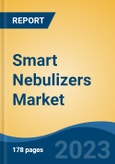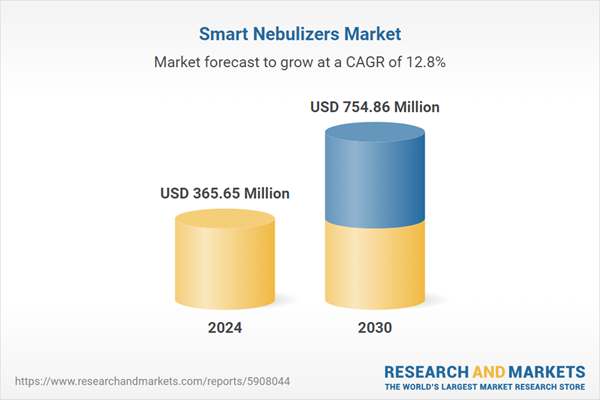Speak directly to the analyst to clarify any post sales queries you may have.
10% Free customizationThis report comes with 10% free customization, enabling you to add data that meets your specific business needs.
Due to hectic schedules, many individuals struggle to maintain a balanced diet, resulting in nutrient deficiencies. Consequently, there has been a significant rise in the consumption of Smart Nebulizers to fulfill daily nutrient and vitamin requirements, promoting overall health and vitality. Furthermore, the increasing healthcare expenditure worldwide is anticipated to drive the demand for Smart Nebulizers. Additionally, the growing elderly population in both developed and developing economies presents lucrative opportunities for market players in the forecast period. The senior population, in particular, relies on Smart Nebulizers to meet their dietary needs, promote bone health, and support overall well-being.
Key Market Drivers
Rising Prevalence of Respiratory Diseases
The rising prevalence of respiratory diseases is one of the most significant drivers of growth in the Global Smart Nebulizers Market. As the global burden of chronic respiratory conditions such as asthma, chronic obstructive pulmonary disease (COPD), cystic fibrosis, and bronchitis continues to increase, there is a growing demand for advanced, efficient, and patient-friendly drug delivery solutions. Chronic obstructive pulmonary disease (COPD) ranks as the fourth leading cause of mortality globally, accounting for 3.5 million deaths in 2021, or approximately 5% of total worldwide fatalities. A striking 90% of COPD-related deaths among individuals under 70 years old occur in low- and middle-income countries (LMICs).Smart nebulizers, which offer automated medication administration, real-time tracking, and improved drug delivery efficiency, are becoming an essential tool in respiratory disease management. The prevalence of respiratory diseases is steadily increasing due to multiple factors, including air pollution, smoking, occupational hazards, and climate change. According to the World Health Organization (WHO) Over 262 million people suffer from asthma, making it one of the most common chronic diseases worldwide. Respiratory infections and chronic lung diseases are key contributors to morbidity and healthcare costs. As these conditions require long-term medication and regular management, the demand for efficient, reliable, and connected drug delivery devices like smart nebulizers is rising.
Key Market Challenges
Regulatory Hurdles and Compliance
One of the foremost challenges facing the Global Smart Nebulizers Market is the intricate regulatory environment governing medical devices and healthcare technologies. The strict regulations imposed by various national and international regulatory bodies, such as the FDA in the United States and the European Medicines Agency (EMA) in Europe, can significantly slow down the market's progress.Regulatory agencies prioritize patient safety. Smart nebulizers, which involve the administration of medication directly into the respiratory system, require rigorous testing and compliance with stringent safety standards to ensure patient well-being. Smart nebulizers often collect and transmit patient data, raising concerns about data accuracy and privacy. Compliance with data protection regulations, such as GDPR in Europe, adds complexity to product development. Navigating different regulatory standards across regions can be challenging for manufacturers aiming for global market penetration. Achieving compliance with multiple sets of regulations can be time-consuming and costly.
The rigorous regulatory requirements can lead to delays in product development and approval, extending the time to market entry. Businesses must allocate significant resources for regulatory compliance, including extensive testing and documentation. Compliance with region-specific regulations may result in product variations, leading to market fragmentation and complicating global marketing efforts.
Key Market Trends
Telehealth Integration
One prominent trend in the Global Smart Nebulizers Market is the integration of smart nebulizers into telehealth platforms. This convergence aligns with the broader shift towards telemedicine and remote patient monitoring, presenting several key drivers for its adoption.Telehealth offers patients convenient access to healthcare services, especially in remote or underserved areas. Smart nebulizers integrated into telehealth platforms enable remote consultations with healthcare providers for respiratory care. Smart nebulizers connected to telehealth systems provide real-time data on medication administration and patient response. Healthcare providers can monitor patients' progress more effectively, allowing for timely interventions if needed. Telehealth integration facilitates medication adherence tracking, ensuring patients are following their prescribed regimens. This can lead to better health outcomes and reduced hospitalizations.
Businesses involved in smart nebulizer manufacturing can tap into the growing telehealth market, expanding their product reach and customer base. Collaborative efforts with telehealth providers can lead to innovative solutions that bridge the gap between medical devices and healthcare services.
Key Market Players
- OMRON Corporation
- Briggs Healthcare Ltd.
- Vectura Group Ltd
- PARI GmbH
- Koninklijke Philips N.V.
- Briutcare
- GE HealthCare Inc
- AireHealth Inc
- Beurer GmbH
- BPL Medical Technologies Pvt Ltd
Report Scope:
In this report, the Global Smart Nebulizers Market has been segmented into the following categories, in addition to the industry trends which have also been detailed below:Smart Nebulizers Market, By Type:
- Portable Smart Nebulizers
- Handheld Smart Nebulizers
- Table-top Smart Nebulizers
Smart Nebulizers Market, By Application:
- Chronic Obstructive Pulmonary Disease (COPD)
- Cystic Fibrosis
- Asthma
- Others
Smart Nebulizers Market, By End-User:
- Hospitals & Clinics
- Emergency Centers
- Home Healthcare
Smart Nebulizers Market, By Region:
- North America
- United States
- Canada
- Mexico
- Europe
- France
- United Kingdom
- Italy
- Germany
- Spain
- Asia-Pacific
- China
- India
- Japan
- Australia
- South Korea
- South America
- Brazil
- Argentina
- Colombia
- Middle East & Africa
- South Africa
- Saudi Arabia
- UAE
Competitive Landscape
Company Profiles: Detailed analysis of the major companies present in the Global Smart Nebulizers Market.Available Customizations:
With the given market data, the publisher offers customizations according to a company's specific needs. The following customization options are available for the report.Company Information
- Detailed analysis and profiling of additional market players (up to five).
This product will be delivered within 1-3 business days.
Table of Contents
Companies Mentioned
- OMRON Corporation
- Briggs Healthcare Ltd.
- Vectura Group Ltd
- PARI GmbH
- Koninklijke Philips N.V.
- Briutcare
- GE HealthCare Inc
- AireHealth Inc
- Beurer GmbH
- BPL Medical Technologies Pvt Ltd
Table Information
| Report Attribute | Details |
|---|---|
| No. of Pages | 180 |
| Published | March 2025 |
| Forecast Period | 2024 - 2030 |
| Estimated Market Value ( USD | $ 365.65 Million |
| Forecasted Market Value ( USD | $ 754.86 Million |
| Compound Annual Growth Rate | 12.8% |
| Regions Covered | Global |
| No. of Companies Mentioned | 10 |









